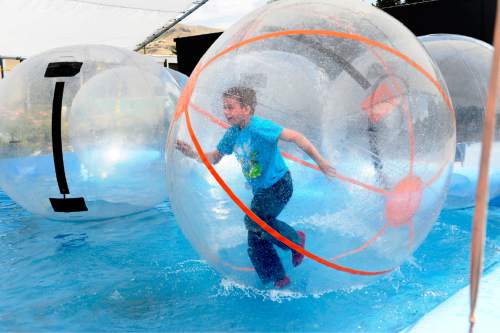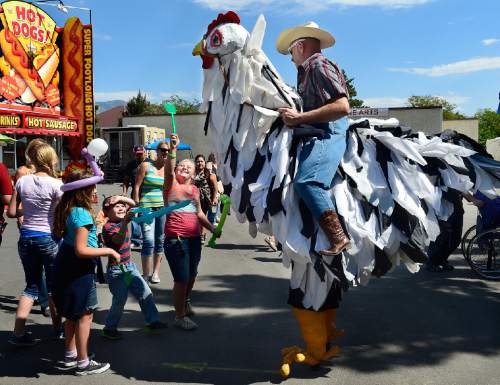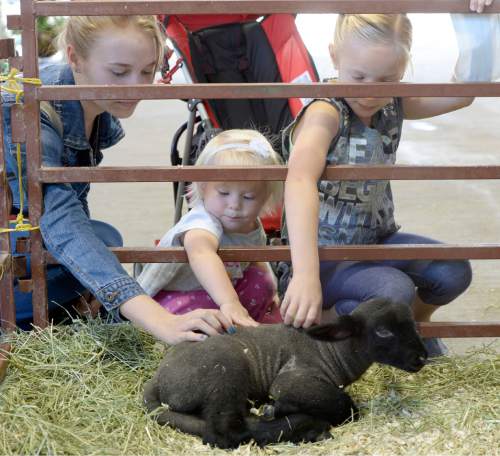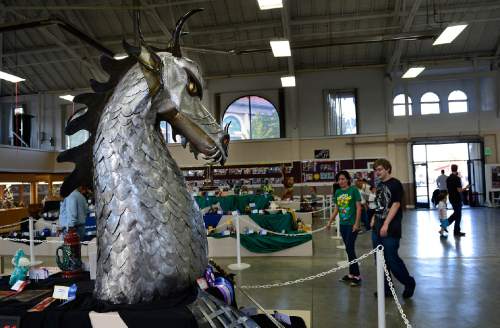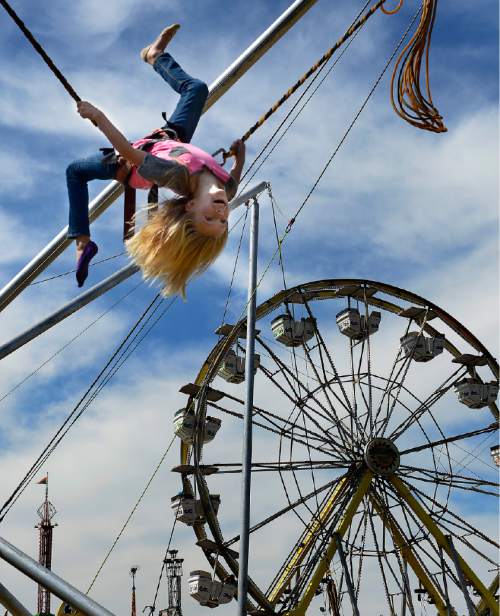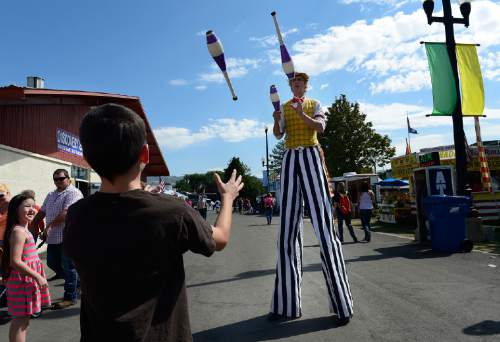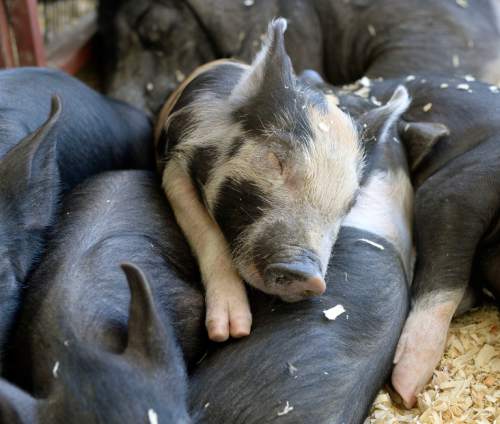This is an archived article that was published on sltrib.com in 2015, and information in the article may be outdated. It is provided only for personal research purposes and may not be reprinted.
The Utah State Fair returns for its 160th run on Thursday, promising cows and clowns and deep-fried delights — but the fair's future looks as bumpy as a carnival ride, as Utah lawmakers consider the fate of the event's traditional North Temple location.
Ted Lewis, the interim director of the Utah State Fairpark Corp., which manages the land year-round and organizes the Utah State Fair, is optimistic. "I haven't heard anything but supportive comments from legislators to keep the state fair alive and well," Lewis said.
The Fairpark grounds, at North Temple and 1000 West in Salt Lake City, have been the fair's home since 1902. The land is owned by the state of Utah, which leases it for a nominal fee to the Fairpark Corp.
Here's the hitch: The current lease runs out in 2017, and renewal has been stalled as the Utah Legislature considers the Fairpark's future. If the lease isn't renewed, next year's Utah State Fair could be the last.
What lawmakers want to know is whether the Fairpark Corp. can become truly self-sustaining, as the Legislature ordered in 1995.
"There are not many businesses that can sustain themselves for a whole year with 10 days that are income-producing," said Sen. Kevin Van Tassell, R-Vernal, who co-chairs a joint ad hoc committee tasked with looking at the Fairpark's lease.
Lewis, who was named interim director in July after executive director Michael Steele quit for a private-sector job, said those 10 days of the fair are important. The Utah State Fair, Lewis said, "is the largest single public event in Utah each year."
(Lewis, a retired attorney for Beneficial Life, knows the Fairpark well. He lives a couple of blocks away from it. He has served on the Fairpark board of directors for the past few years, and he represented this district in the Utah House from 1983 to 1992.)
Last year, some 300,000 people attended the Utah State Fair. That was the highest total in five years, as attendance hovered between 260,000 and 280,000 a year, according to a February 2014 report by the Legislative Auditor General.
One of the state fair's historic roles is to spotlight Utah agriculture. For the estimated 95 percent of Utah's population that lives in an urban area, either on the Interstate 15 corridor or the Wasatch Back, that's a major draw, Van Tassell said.
"If they want to see a cow being milked, they can see that [at the fair]," Van Tassell said.
"The fair's best friends and best supporters since the beginning have been the agricultural interests," Lewis said.
Another draw is entertainment. This year, Lewis said, the state fair is trying something different in the grandstand: a weeklong run of the Royal Hanneford Circus, a one-ring touring extravaganza with clowns, acrobats, animal acts and the like. The circus will perform at 1, 4 and 7 p.m. daily from Monday, Sept. 14, through Sunday, Sept. 20, the fair's last day.
And, unlike the headlining music acts that have played the grandstand in previous years, the circus performances will be free with fair admission. Seating is limited, and tickets will be handed out two hours before showtime, Lewis said.
Though musical acts — last year's lineup included classic bands The Beach Boys and Grand Funk Railroad, and Disney Channel singing star Zendaya — have drawn crowds, Lewis said the profit margins were thin.
"It's always been hard to make money on those, because you have to pay the bands their full fee," Lewis said. "We've seldom made much money on those, and we've often lost money."
Among its many revenue streams — gate receipts, concession stands, carnival rides, vendor booth rentals and parking fees — "in a normal year, the fair makes money," Lewis said. "It's the use of the facilities the rest of the year that needs to be looked at."
When the state fair isn't running, the Fairpark rents out its space to all manner of short-term events — including wedding receptions, model-train shows, Pokemon tournaments and the Vans Warped Tour rock festival.
The lease issue has stymied long-term development. It was cited as one of the reasons businessman and Real Salt Lake owner Dell Loy Hansen withdrew plans to build a soccer-specific stadium at the Fairpark for RSL's minor-league farm team, Real Monarchs. (Hansen instead chose a site in West Valley City.)
Also at issue is the state of the Fairpark's facilities. Van Tassell said some buildings will require renovation so the Fairpark can charge higher rental fees. "At the end of the day, we're going to have to spend some money," Van Tassell said.
Sen. Luz Escamilla, D-Salt Lake City, also sits on the ad hoc committee — and she reminds people that there's more to the Fairpark than making money.
"It's part of who we are in the west side of Salt Lake City," said Escamilla, whose district includes the Fairpark.
Escamilla, still smarting over the debate to move the state prison to Salt Lake City's west side, is concerned developers have their sights set on the Fairpark. "It's prime-time real estate," she said.
Van Tassell also noted the potential desirability of the Fairpark land to private enterprise. "There's just not that many 60-acre-plus parcels that close to downtown," Van Tassell said.
Van Tassell, however, compared the Fairpark to other areas in Utah, such as This Is the Place Heritage Park, that should be maintained for their cultural and historic significance.
He also acknowledged the Fairpark's importance to its surrounding neighborhoods. "Everyone in the state needs something to identify with," Van Tassell said. "For Rose Park and Glendale, that is what they identify with."
Lawmakers will get to see firsthand what the Utah State Fair means as they meet to discuss the Fairpark's future. The ad hoc committee's first meeting is Friday at 2 p.m. — the second day of the fair — in the Fairpark's board room. The committee ultimately will make a recommendation to Gov. Gary Herbert.
Twitter: @moviecricket —
Utah State Fair
The 160th annual Utah State Fair.
Where • Utah State Fairpark, 1000 W. North Temple, Salt Lake City.
When • Sept. 10-20.
Hours • 10 a.m. to 10 p.m. most days; open until 11 p.m. on Fridays and Saturdays; opens at noon on Tuesday, Wednesday and Thursday, Sept. 15-17.
Admission • $10 for adults, $7 for seniors (62 and over) and youth (6 to 12), free for children 5 and under; at the fair box offices.
Discounts • Save $2 on adult admission by purchasing tickets at Smith's Food & Drug checkout stands.
Highlights
• The Royal Hanneford Circus, performing three shows a day in the grandstand, Sept. 14-20; free with fair admission; tickets are limited, and will be distributed two hours before showtime.
• "Searching for the Seventies," a touring photo exhibit from the Smithsonian Institution depicting life in America in the 1970s.
• Kachunga and the Alligator Show, a touring wildlife show.
• "Day of Wreckoning" demolition derby, Sept. 19.
• Utah's Own PRCA Rodeo, Sept. 10-13.


